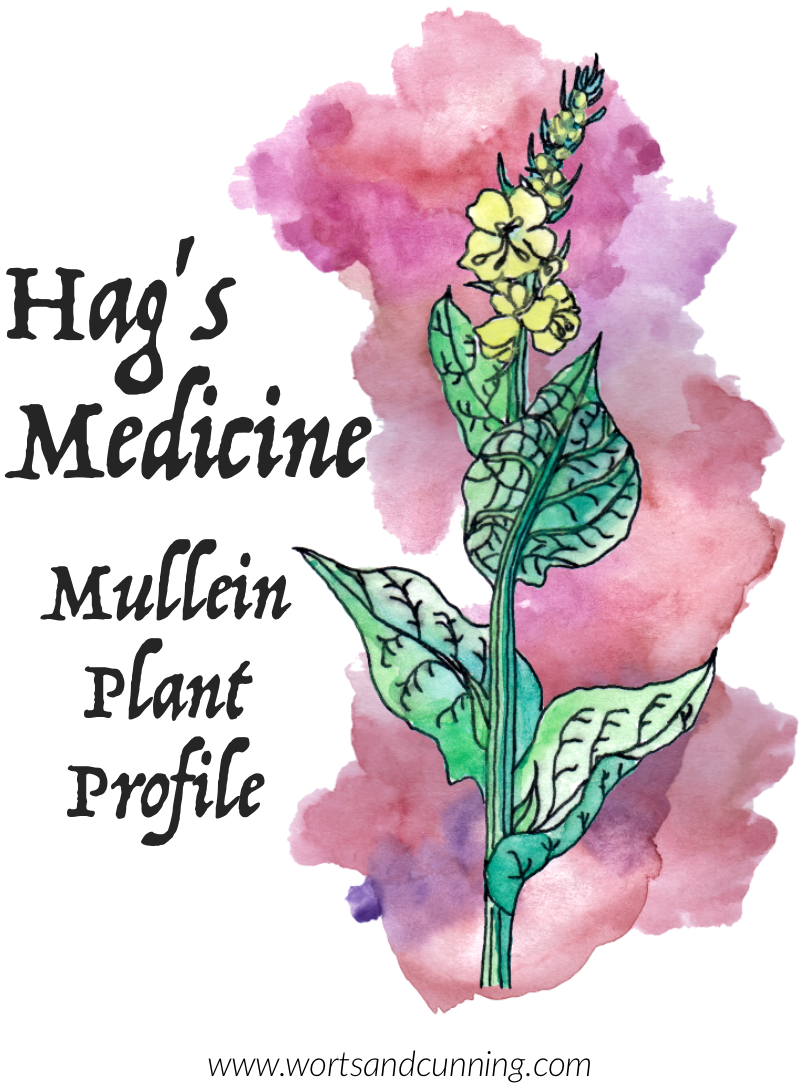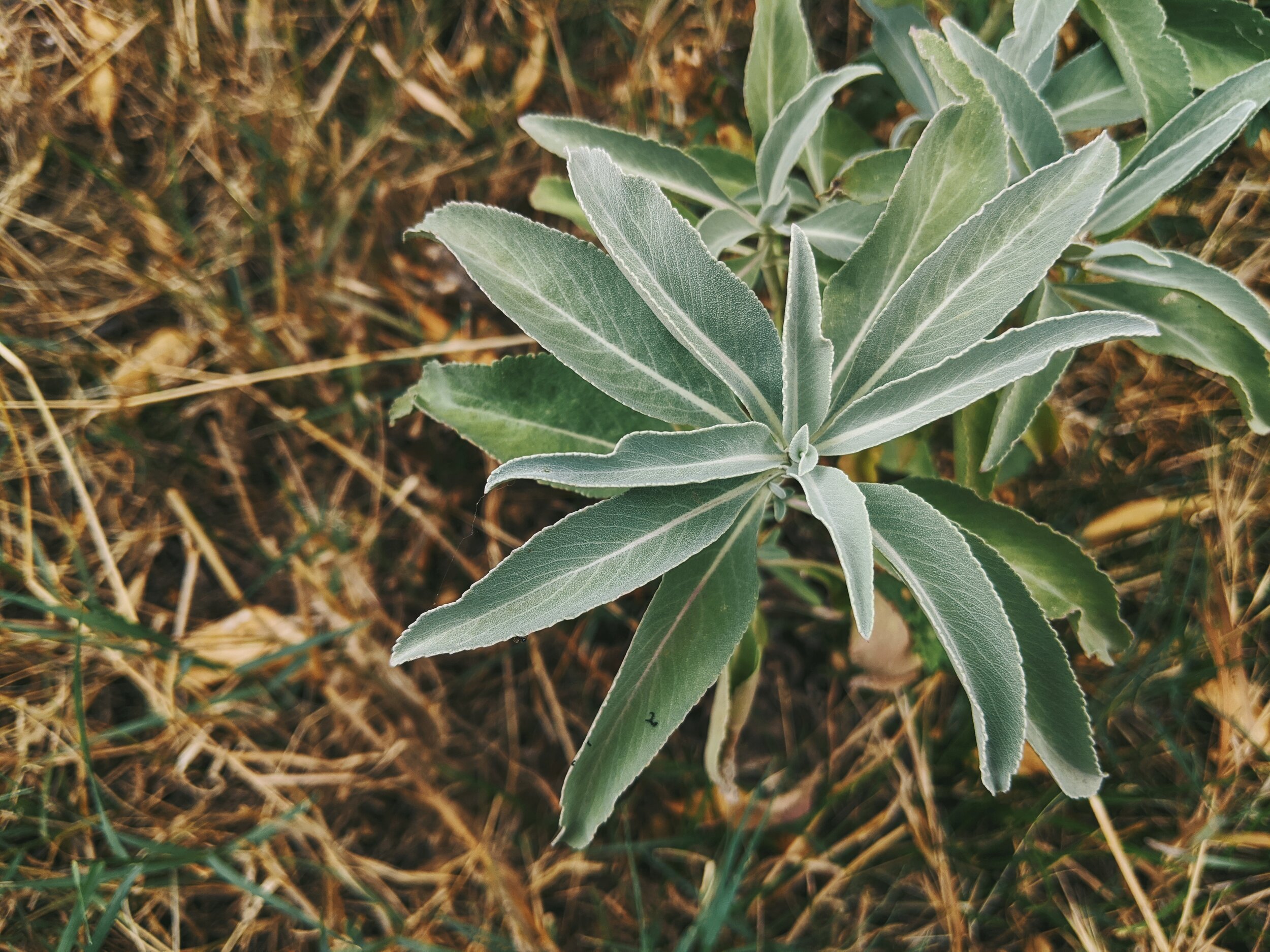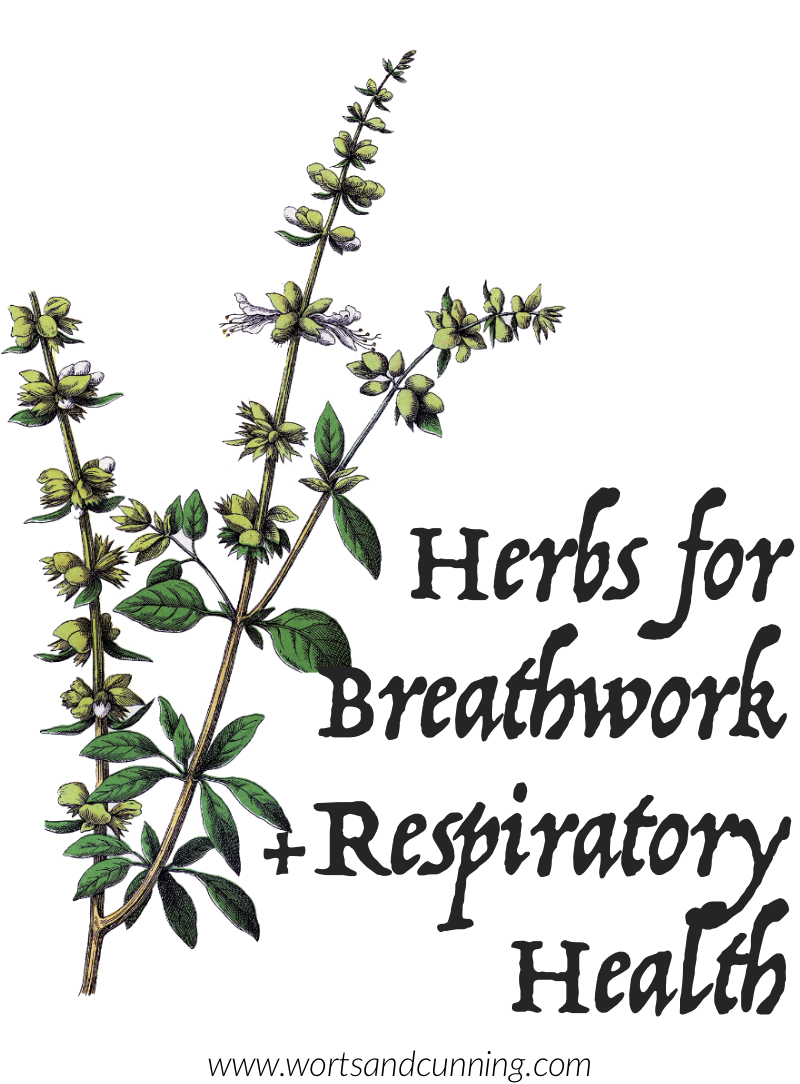Hag's Medicine: Mullein Plant Profile
I realized that it’s been a few months since I wrote my last plant profile for all of you and continuing the last few posts on breathwork and herbs for respiratory wellness, Mullein (Verbascum thapsus) felt like the wonderful ally to celebrate and learn from this month. So let’s do just that!
Mullein
(Verbascum thapsus)
Common + Folk Names : Hag’s tapers, beggar’s blanket, graveyard dust, candlewick, Jupiter’s staff, torches, velvet dock, witch’s candle, lungwort, shepherd’s staff, duffle, fluffweed, fleawort, tinder plant, Cuddy's lungs, hare’s beard, Our Lady’s flannel, Quaker rouge, Aaron's rod, Jacob's staff, verbasco, Nookaadiziiganzh.
Tarot Cards : The Devil, The World, Two of Pentacles - learn more about tarot + herbs
Element : Earth, Water
Zodiac Signs : Capricorn
Planets : Saturn
Moon Phase : Waning Quarter Moon
Parts used : Leaf, flower, root
Habitat : Native to Eurasia and North Africa but naturalized throughout North America.
Growing conditions : Grows in waste areas and roadsides. Likes full sun and well-drained soil.
Collection : Collect the flowers and leaves from second year and older plants. Roots in the fall.
Flavor : Pungent, slightly bitter
Temperature : Cool
Moisture : Moist
Tissue State : Damp/Stagnation, Dry/Atrophy
Constituents : Carotene, choline, calcium, magnesium, sulfur, resin, saponins, glycoside, flavonoids, mucilage, tannins, triterpenes, volatile oil.
Actions : alterative, anodyne, antibacterial, antihistamine, anti-inflammatory, antiseptic, antispasmodic, antiviral, astringent, decongestant, demulcent, diuretic, emollient, expectorant, pectoral, vulnerary. Flower: analgesic, anti-inflammatory, antispasmodic, demulcent, emollient, mucilaginous, nervine, sedative. Root: anti-inflammatory, antispasmodic, anodyne, diuretic, nervine.
Main Uses : Mullein is described by Nicholas Culpeper as being under the guardianship of Saturn, which is in part why the herb is considered a plant of Capricorn. The herb is a great ally during the winter months, helping to clear phlegm from the system, reduce inflammation, and protect against infection. It is excellent for clearing out chronic, long-standing coughs, especially dry and spasmodic coughs, and can help with a number of respiratory complaints including bronchitis, asthma, and general lung weakness. Mullein has traditionally been used for tuberculosis, whooping cough, and pleurisy. Bartram's Encyclopedia of Herbal Medicine describes a traditional Irish preparation of Mullein for the treatment of tuberculosis prepared by adding a handful of the green leaves to two pints of fresh milk, strained, and then sweetened with honey which was then drunk once or twice daily. Think deep, thick, and chesty coughs. Look for signs of adrenal stress, especially after long bouts of illness and conditions worsening when lying down.
Add the herb to your cold and flu blends with Elder (Sambucus nigra) and Peppermint (Mentha piperita) for a lung-opening, immunomodulating blend. Mullein is useful, too, for Capricorn folk who tend towards stagnant cold states which lead to swellings and cysts as the herb helps to dissolve such manifestations of buildup. As a decongestant, Mullein is good for allergies such as hay fever, helping to clear phlegm and relieve pain. In her Physica, Hildegard von Bingen recommended Mullein for “one who is hoarse or has a pain in his chest” recommending that they combine the herb with Fennel (Foeniculum vulgare) in a medicinal wine. Use also for asthma (especially if there is heat and aggravation) and general chest infections. Mullein has immunostimulating properties which is another reason that it is excellent for cold and flu season and especially for someone succumbing to chronic viral infections. The herb is effective against viruses such as herpes, too.
As a moistening diuretic, Mullein helps to soothe an inflamed urinary system and help with the release of urine. Mullein is also well-suited for many cases of edema and water retention. The herb also helps to remove toxins from the body because of its ability to move water out of the body. Use in cases of arthritis, rheumatism, gout, UTIs, and cystitis. As a digestive, Mullein is a mild bitter that relieves indigestion, especially in cases of a damp and stagnant digestion, and can help alleviate the pain of peptic ulcers.
Mullein can be used for nerve pain and combines well with other nervines such as Skullcap (Scutellaria lateriflora) and St. Joan’s Wort (Hypericum perforatum). Use internally as well as an oil for neuralgia and especially nerve pain the hands and feet. In particular, the root can be used in cases of Bell’s palsy and facial nerve pain. The herb helps to loosen up stiff joints and connective tissue.
Topically, the mucilaginous Mullein is excellent for dry skin conditions but also as a healing compress or salve for boils, bruises, inflammation, hemorrhoids, eczema, sciatica, and joint pain. Use in a steam for lung conditions like asthma, bronchitis and other respiratory imbalances already described. In Plants Have So Much to Give Us, All We Have To Do Is Ask: Anishinaabe Botanical Teachings, Mary Siisip Geniusz recommends following a steam with Mullein a cup of Yarrow (Achillea millefolium) and then to bed to clear the head and chest. Mullein is used similarly as a smoking herb as well as an aid to help wean off tobacco. Mullein is useful in cases of bulging discs and bone setting. The herb helps the skin repair after a wound, burn, sore, and ulcer and can be used for skin infections, too. A compress of the leaves is excellent for alleviating the pain of swollen joints, sore muscles, swollen glands, eczema and for headaches. Use also for lymphadenitis and mumps. Create a gargle of the tea or extract for laryngitis, swollen gums, and tonsillitis. Mullein and garlic ear oil is a trusted remedy for ear infections helping to relieve pain and infection. I always keep a small bottle of Mullein and Garlic oil in my home care kit just for this reason. Mullein is also a common herb in smoking blends.
Magickal Uses : The long thick stems are sometimes referred to as Hag’s Tapers (the dried stalks dipped in wax will burn as a somewhat messy candle) as they are associated with the magickal workings of Witchfolk. Mullein is a plant long associated with the working of Hags - the womxn overculture has always feared who teach us to embrace what has been deemed unpalatable to value systems that our not our own into essential tools of our self-understanding. Burn at the initiation rites of transwomxn stepping into their power. The tapers can be burned at rituals of all kinds as well as funerals to protect against unwanted and malevolent spirits. You can also tuck the leaves into your shoe for added comfort and protection on your journeys. Use for general protection against sorcery, the evil eye, and malevolent spirits. Specifically protective against wild animal attacks and guards against the Night Mare. Use as a substitute for graveyard dust in spells and charms. Burn Mullein in your Midsummer bonfire for protection and gather the ashes to use in protection charms.
The Mullein Personality : The Mullein person has something to get off their chest which can sometimes manifest as chronic respiratory infections and a barking cough that doesn’t allow them to get a clear word out. Their adrenals are often run down and mornings - just as they are getting out of bed - can be some of the most difficult times for them physically and emotionally. Often, Mullein folk come off as dried out (which can manifest in their physical symptoms), but they may appear dry because all of their waters have pooled deep in the body. With their unexpressed truth settling in the body they are stewing, sometimes even bubbling over. They need to learn how to light their torch, even if the words that come out aren’t “perfectly” illuminating or fit in with the standards that they or others hold them to. Mullein folk can be confused about what they stand for because they have been so focused on “correct” social customs and traditions. Mullein will help them to become honest with themselves and release these stagnant patterns of seeking authority outside of themselves and help them to speak their words. Ultimately, they learn that morals, values, and laws aren’t of any use unless they align with their morals, values, and inner sense of lawful justice.
Contraindications : Considered generally safe.
Drug interactions : None known.
Dosage : Standard dosage.
Recipe: The following tea is useful for alleviating the pain and tension of backache and neuralgia. It can also be made into an herbal oil or liniment and used topically.
Stand Tall Tea
1 part Nettles (Urtica dioica)
1/2 part Mullein Leaf + Flower (Verbascum thapsus)
1/2 part St. Joan’s Wort (Hypericum perforatum)
Optional: 1/2 part Ginger (Zingiber officinalis)
Add the Ginger if the condition is worse with cold and better with heat. Sweeten with honey or coconut sugar and milk of choice.
I write more about Mullein and it’s uses as an herbal ally for fire season and it is featured in my list of herbs for breathwork and respiratory wellness. Mullein is one of my favorite herbs to use for Capricorn energy and learning more about the sign helps to understand the energy and magick that Mullein offers. Of course, you can always follow the tag for Mullein to see where it might guide you.
If you like plant profiles, be sure to check out the ones I’ve written. I also create plant profiles just for my Patreon community like my one on bright and bold Calendula (Calendula officinalis). Enjoy!
This post was made possible through patron support.
❤︎ Thanks, friends. ❤︎



































